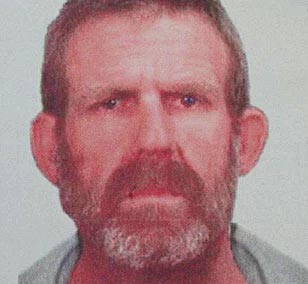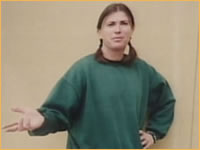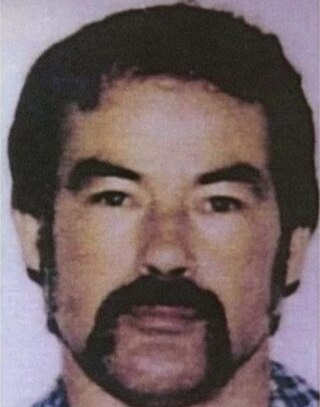Related Research Articles

Janelle Patton was a 29-year-old Sydney woman who was murdered on Norfolk Island on 31 March 2002. The case made national headlines in Australia and New Zealand, as she was the first person to be murdered on Norfolk Island since 1893.

The Darwin Correctional Centre, an Australian minimum to maximum security prison for males and females, is approximately 30 kilometres (19 mi) by road from Darwin, Northern Territory, Australia. The centre is managed by Northern Territory Department of Correctional Services, of the Government of the Northern Territory. The centre detains sentenced and charged felons under Northern Territory and/or Commonwealth law.

Anita Lorraine Cobby was a 26-year-old Australian woman from Blacktown, New South Wales, who was kidnapped while walking home from Blacktown railway station just before 10:00 p.m. on 2 February 1986, and subsequently sexually assaulted and murdered.

The Claremont serial killings is the name given by the media to a case involving the disappearance of an Australian woman, aged 18, and the killings of two others, aged 23 and 27, in 1996–1997. After attending night spots in Claremont, a wealthy western suburb of Perth, Western Australia, all three women disappeared in similar circumstances leading police to suspect that an unidentified serial killer was the offender. The case was described as the state's biggest, longest running, and most expensive investigation.
Peter Falconio was a British tourist who disappeared in a remote part of the Stuart Highway near Barrow Creek in the Northern Territory of Australia on the evening of 14 July 2001, while travelling with his girlfriend Joanne Lees.

Belanglo State Forest is a planted forest, of mainly pine but some native forestry around the edges, open to the public, in the Australian state of New South Wales; its total area is about 3,800 hectares. The Belanglo State Forest is located south of Berrima in the Southern Highlands, three kilometres west of the Hume Highway between Sydney and Canberra. The forest is owned by the New South Wales Government and contains some of the earliest pine plantings in the state. The first radiata pines were planted in this area in 1919.
The backpacker murders were a spate of serial killings that took place in New South Wales, Australia, between 1989 and 1993, committed by Ivan Milat. The bodies of seven missing young people aged 19 to 22 were discovered partially buried in the Belanglo State Forest, 15 kilometres (9.3 mi) south-west of the New South Wales town of Berrima. Five of the victims were foreign backpackers and two were Australians from Melbourne. Milat was convicted of the murders on 27 July 1996 and was sentenced to seven consecutive life sentences, as well as 18 years without parole. He died in prison on 27 October 2019, having never confessed to the murders for which he was convicted.

Bradley John Murdoch is an Australian criminal serving life imprisonment for the July 2001 murder of English backpacker Peter Falconio in Australia. He will be 74 when eligible for parole in 2032. Murdoch is being held in Darwin Correctional Centre in Darwin, Northern Territory. He has lodged two appeals against his conviction, both of which were unsuccessful. The High Court of Australia refused special leave to appeal on 21 June 2007. He is forbidden to talk to the press.

Wolf Creek is a 2005 Australian horror film written, co-produced and directed by Greg McLean and starring John Jarratt, Nathan Phillips, Cassandra Magrath and Kestie Morassi. Its plot concerns three backpackers who find themselves taken captive and subsequently hunted by Mick Taylor, a sadistic, psychopathic, xenophobic serial killer, in the Australian outback. The film was ambiguously marketed as being "based on true events", while its plot bore elements reminiscent of the real-life murders of backpackers by Ivan Milat in the 1990s and Bradley Murdoch in 2001, both of which McLean used as inspiration for the screenplay.
The Wanda Beach Murders, also known simply as "Wanda", were the unsolved murders of Marianne Schmidt and Christine Sharrock at Wanda Beach near Cronulla in Sydney, New South Wales, Australia, on 11 January 1965. The victims, both aged 15, were best friends and neighbours from the suburb of West Ryde, and their partially buried bodies were discovered the next day. The brutal nature of the slayings and the fact that they occurred on a deserted, windswept beach brought massive publicity to the case. By April 1966, police had interviewed some 7,000 people, making it the largest investigation in Australian history. It remains one of the most infamous unsolved Australian murder cases of the 1960s, and New South Wales' oldest unsolved homicide case.
Ginny Dougary is a British interviewer and feature writer for The Times. She is the author of The Executive Tart & Other Myths, and a contributor to several anthologies including OK, You Mugs and Amazonians - New Travel Writing by Women. She is a founding member of the national organisation of Women in Journalism, has written for most of the national newspapers in the United Kingdom.

Paul Charles Denyer is an Australian serial killer currently serving three consecutive sentences of life imprisonment with a non-parole period of 30 years for the murders of three young women in Melbourne, in 1993. Denyer became known in the media as the Frankston Serial Killer as his crimes occurred in the neighbouring suburbs of Frankston.
Andrew Mark Mallard was a British-born Australian who was wrongfully convicted of murder in 1995 and sentenced to life imprisonment. Almost 12 years later, after an appeal to the High Court of Australia, his conviction was quashed and a retrial ordered. However, the charges against him were dropped and Mallard was released. At the time, the Director of Public Prosecutions stated that Mallard remained the prime suspect and that if further evidence became available he could still be prosecuted. He was released from prison in 2006 after his conviction was quashed by the High Court, and was paid $3.25 million compensation by the state government. The Western Australian Commission on Crime and Corruption investigated whether there was misconduct by any public officer associated with this case and made findings against two policemen and a senior prosecutor.

Joanne Lees: Murder in the Outback is a television film produced by Channel Ten and ITV Productions, which first aired in Australia on Channel Ten on 18 March 2007 and in the UK on ITV on Sunday 8 April, where it was titled Murder in the Outback. It is based on the real life disappearance of Peter Falconio.

Joanne Froggatt is a British actress. From 2010 to 2015, she portrayed Anna Bates in the ITV period drama series Downton Abbey, for which she received three Emmy nominations and won the 2014 Golden Globe Award for Best Supporting Actress. From 2017 to 2020, she starred as Laura Nielson in the ITV/Sundance drama series Liar.
Spencer Campbell is an English television producer and director. He is perhaps best known for producing the television series Cold Feet and 4 O'Clock Club, the former of which earned him a BAFTA TV Award in 2002.
Tina Watson was a 26-year-old American woman from Helena, Alabama, who died while scuba diving in Queensland, Australia, on 22 October 2003. Tina had been on her honeymoon with her new husband, fellow American Gabe Watson, who was initially charged by Queensland authorities with his wife's murder. Watson pleaded guilty to manslaughter and was sentenced to a term of imprisonment.

Ivan Robert Marko Milat, commonly referred to in media as the Backpacker Murderer, was an Australian serial killer who abducted, assaulted, robbed and murdered two men and five women in New South Wales between 1989 and 1992. His modus operandi was to approach backpackers along the Hume Highway under the guise of providing them transport to areas of southern New South Wales, then take his victims into the Belanglo State Forest where he would incapacitate and murder them. Milat is also suspected of having committed many other similar offences and murders around Australia.
The murders of Karlie Pearce-Stevenson and Khandalyce Pearce were initially treated as unrelated. The skeletal remains of Pearce-Stevenson were found in Belanglo State Forest, New South Wales, Australia in 2010. Her daughter Khandalyce Pearce's remains were found near Wynarka, South Australia in July 2015. The two cases were not linked until positive identification was confirmed by DNA testing in October 2015. The mother and daughter were last seen by family in 2008 in Alice Springs, Northern Territory and reported missing in 2009; however, the report was withdrawn. It was discovered Pearce-Stevenson's mobile phone was used for years following her death to send false "proof of life" messages to family and friends. The mother and child's identities were exploited by third parties to commit social security and other types of identity fraud.

Casefile True Crime Podcast, or simply Casefile, is an Australian crime podcast that first aired in January 2016 and is hosted by an Australian man who remains anonymous. The podcast is released on a Sunday (EST) for three consecutive weeks, with a break on the fourth week. The series deals with solved or cold criminal cases, often related to well-known murders and serial crimes. Many early episodes relate to Australian cases, although notable crimes from the UK and the US are increasingly featured, and well-known cases from other countries have also been included. Unlike a number of similar podcasts, the series is scripted and narrative, relying primarily on original police or mass-media documents, eyewitness accounts, and interview or public announcement recordings. Larger and more-complex cases have received multiple-week serialised broadcasts, and case updates to previously aired cases are also provided from time to time. The series has been well received, and has won a number of awards since its debut.
References
- ↑ Dougary, Ginny.Joanne Lees: My Story. "She turned 33 on September 25 [2006]"
- 1 2 3 4 5 6 "Case 44: Peter Falconio – Casefile: True Crime Podcast". Casefile: True Crime Podcast. 29 January 2017. Retrieved 1 March 2018.
- ↑ Murdoch, Lindsay (19 October 2005). "Lees relives night she feared she'd die". The Sydney Morning Herald . Retrieved 4 February 2017.
- ↑ "'I thought I was going to die', says sobbing Lees". The Sydney Morning Herald. 18 October 2005. Retrieved 4 February 2017.
- ↑ "'Flaws' in evidence of Outback murder victim's girlfriend". The Telegraph. 20 October 2005.
- ↑ "Murder in the outback". The Times. London. 2 October 2006.
- ↑ Enough Rope with Andrew Denton - episode 124: Joanne Lees (09/10/2006)
- ↑ James Delingpole. "Joanne deserves more than scorn". The First Post. Archived from the original on 12 October 2006. Retrieved 13 December 2006.
- ↑ "Lees attacks 'sensational' media". BBC. 9 October 2006. Retrieved 9 April 2007.
- ↑ "Joanne Lees still single ten years after murder of boyfriend Peter Falconio". The Daily Telegraph. Retrieved 7 July 2011.
- ↑ Why Joanne Lees is creating a memorial for Peter Falconio at 9now.com.au, February 2017